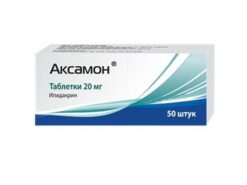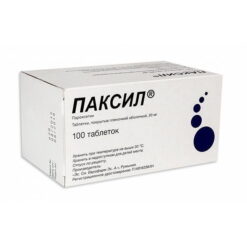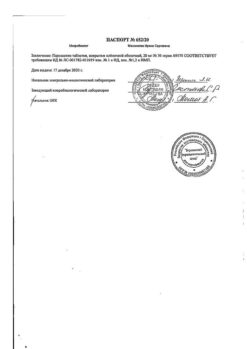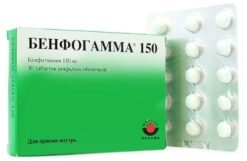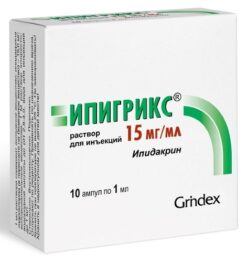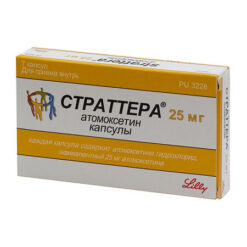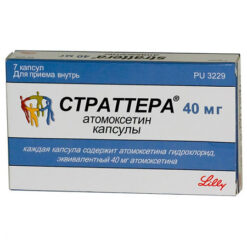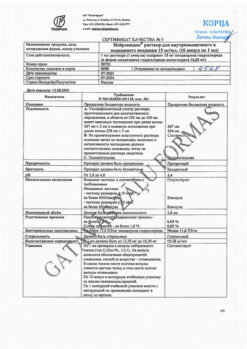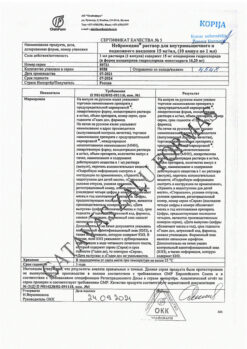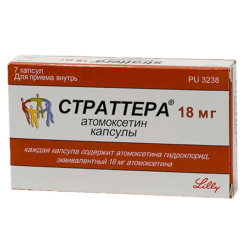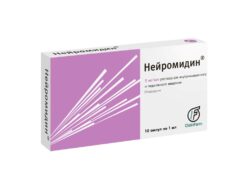Subtotal: €31.29
Paroxetine-SZ, 20 mg 30 pcs
€8.35 €7.31
Out of stock
(E-mail when Stock is available)
Pharmacotherapeutic group: antidepressant.
ATX code: N06AB05
Pharmacological properties
Pharmacodynamics
Mechanism of action
Paroxetine is a potent and selective inhibitor of
5- hydroxytryptamine (5-HT, serotonin) reuptake. Its antidepressant activity and efficacy in the treatment of obsessive-compulsive disorder (OCD) and panic disorder is generally believed to be due to specific inhibition of 5-HT reuptake in brain neurons.
Paroxetine differs chemically from tricyclic, tetracyclic and other known antidepressants.
Paroxetine is characterized by low affinity for muscarinic cholinergic receptors, and animal studies have shown that it has only weak anticholinergic properties.
In keeping with this selective action of paroxetine, studies in vitro it has been shown that, unlike tricyclic antidepressants, it has little affinity for α-1, α-2, and β-adrenoreceptors, as well as for dopamine (D2), 5-NT1-like, 5-NT2– and histamine (H1) receptors. The lack of interaction with postsynaptic receptors in vitro is confirmed by studies in vivo, which indicate that paroxetine does not depress the central nervous system (CNS) and does not cause arterial hypotension.
Pharmacodynamic properties
Paroxetine does not impair psychomotor function or increase the CNS depressant effect of ethanol.
Like other selective 5-NT reuptake inhibitors, paroxetine causes symptoms of overstimulation of 5-NT receptors when administered to animals that have previously received monoamine oxidase inhibitors (MAOIs) or tryptophan.
In behavioral and EEG assessment studies, paroxetine has been shown to cause weak activating effects at doses greater than those required to inhibit 5-NT reuptake. Its activating properties are not “amphetamine-like” in nature.
In animal studies, good cardiovascular tolerance has been shown.
Paroxetine does not cause clinically significant changes in blood pressure, heart rate and ECG after use in healthy individuals.
Studies have shown that unlike antidepressants, which inhibit norepinephrine reuptake, paroxetine has much less ability to inhibit the antihypertensive effects of guanethidine.
Pharmacokinetics
Intake
Paroxetine is well absorbed after oral administration and undergoes first-pass metabolism.
Due to first-pass metabolism, a smaller amount of paroxetine enters the systemic bloodstream than is absorbed from the gastrointestinal tract. As the amount of paroxetine in the body increases with a single high-dose administration or with multiple conventional doses, there is partial saturation of the first-pass metabolic pathway and a decrease in the clearance of paroxetine from the blood plasma. This results in a disproportionate increase in plasma concentrations of paroxetine, so its pharmacokinetic parameters are inconsistent, resulting in nonlinear kinetics. However, the non-linearity of kinetics is usually insignificant and is observed only in those patients in whom low paroxetine plasma concentrations are achieved at low doses of the drug.
The equilibrium systemic concentrations are reached 7-14 days after initiation of paroxetine treatment, its pharmacokinetic parameters generally do not change during long-term therapy.
Distribution
Paroxetine is widely distributed in tissues, and pharmacokinetic calculations indicate that only 1% of the total amount of paroxetine present in the body remains in plasma.
In therapeutic concentrations, approximately 95% of the plasma paroxetine present is bound to proteins.
No correlation has been found between the plasma concentration of paroxetine and its clinical effects (with adverse reactions and efficacy).
Metabolism
The main metabolites of paroxetine are polar and conjugated oxidation and methylation products that are readily eliminated from the body. Due to the practical absence of pharmacological activity of these metabolites, their contribution to the therapeutic properties of paroxetine is unlikely.
Metabolism does not limit the ability of paroxetine to act on 5-NT reuptake in neurons.
Elimation
Less than 2% of the dose taken is excreted unchanged in the urine, whereas excretion of metabolites reaches 64% of the dose. About 36% of the dose is excreted in the feces, probably entering it with the bile; less than 1% of the dose is excreted unchanged in the feces. Thus, paroxetine is eliminated almost completely by metabolism.
The excretion of metabolites is biphasic: first it is the result of first-pass metabolism, then it is controlled by the systemic elimination of paroxetine.
The elimination half-life of paroxetine varies, but is usually about 1 day.
Special patient groups
Elderly patients, patients with renal or hepatic impairment.
In elderly patients, patients with severe renal or hepatic impairment, plasma concentrations of paroxetine may increase, but the range of its plasma concentrations is the same as in healthy adults.
Indications
Moderate to severe depressive episodes
Recurrent depressive disorder
Results from studies in which patients took paroxetine before
1 year, indicate that it is effective in preventing relapse and return of symptoms of depression.
Obsessive-compulsive disorder
Paroxetine is effective in the treatment of obsessive-compulsive disorder (OCD), including as a means of maintenance and preventive therapy.
In placebo-controlled studies, the effectiveness of paroxetine in the treatment of OCD was maintained for at least 1 year. In addition, paroxetine is effective in preventing relapses of OCD.
Panic disorder
Paroxetine is effective in the treatment of panic disorder with and without agoraphobia, including as a means of maintenance and preventive therapy.
It has been established that in the treatment of panic disorder, the combination of paroxetine and cognitive behavioral therapy is significantly more effective than the isolated use of cognitive behavioral therapy.
In placebo-controlled studies, the effectiveness of paroxetine in the treatment of panic disorder was maintained for more than 1 year. In addition, paroxetine was effective in preventing relapses of panic disorder.
Social phobia
Paroxetine is effective in the treatment of social phobia, including as long-term maintenance and preventive therapy.
The continued effectiveness of paroxetine in the long-term treatment of social phobia was demonstrated in a relapse prevention study.
Generalized anxiety disorder
Paroxetine is effective in the treatment of generalized anxiety disorder, including as long-term maintenance and preventive therapy.
The continued effectiveness of paroxetine in the long-term treatment of generalized anxiety disorder was demonstrated in a relapse prevention study.
Post-traumatic stress disorder
Paroxetine is effective in treating post-traumatic stress disorder
Pharmacological effect
Pharmacotherapeutic group: antidepressant.
ATX code: N06AB05
Pharmacological properties
Pharmacodynamics
Mechanism of action
Paroxetine is a potent and selective reuptake inhibitor
5-hydroxytryptamine (5-HT, serotonin). It is generally accepted that its antidepressant activity and effectiveness in the treatment of obsessive-compulsive disorder (OCD) and panic disorder is due to the specific inhibition of 5-HT reuptake in brain neurons.
In its chemical structure, paroxetine differs from tricyclic, tetracyclic and other known antidepressants.
Paroxetine has low affinity for muscarinic cholinergic receptors, and animal studies have shown that it has only weak anticholinergic properties.
In accordance with this selective action of paroxetine, in vitro studies have shown that, unlike tricyclic antidepressants, it is characterized by negligible affinity for α-1, α-2 and β-adrenergic receptors, as well as for dopamine (D2), 5-HT1-like, 5HT2- and histamine (H1) receptors. The lack of interaction with postsynaptic receptors in vitro is confirmed by the results of in vivo studies, which indicate that paroxetine does not depress the central nervous system (CNS) and does not cause arterial hypotension.
Pharmacodynamic properties
Paroxetine does not impair psychomotor functions and does not enhance the inhibitory effect of ethanol on the central nervous system.
Like other selective 5-HT reuptake inhibitors, paroxetine causes symptoms of excessive stimulation of 5-HT receptors when administered to animals that have previously received monoamine oxidase inhibitors (MAOIs) or tryptophan.
Behavioral and EEG studies have shown that paroxetine produces weak activating effects at doses higher than those required to inhibit 5-HT reuptake. Its activating properties are not “amphetamine-like” in nature.
Animal studies show good cardiovascular tolerability.
After use in healthy individuals, paroxetine does not cause clinically significant changes in blood pressure, heart rate and ECG.
Studies have shown that, unlike antidepressants that inhibit norepinephrine reuptake, paroxetine has much less ability to inhibit the antihypertensive effects of guanethidine.
Pharmacokinetics
Suction
After oral administration, paroxetine is well absorbed and undergoes first-pass metabolism.
Due to first-pass metabolism, less paroxetine enters the systemic circulation than is absorbed from the gastrointestinal tract. As the amount of paroxetine in the body increases, with a single dose of large doses or with multiple doses of usual doses, partial saturation of the first-pass metabolic pathway occurs and the clearance of paroxetine from blood plasma decreases. This leads to a disproportionate increase in paroxetine plasma concentrations, so its pharmacokinetic parameters are variable, resulting in nonlinear kinetics. However, the nonlinearity of the kinetics is usually insignificant and is observed only in those patients in whom low plasma concentrations of paroxetine are achieved while taking low doses of the drug.
Equilibrium systemic concentrations are achieved 7-14 days after the start of treatment with paroxetine; its pharmacokinetic parameters, as a rule, do not change during long-term therapy.
Distribution
Paroxetine is widely distributed in tissues, and pharmacokinetic calculations show that only 1% of the total amount of paroxetine present in the body remains in the plasma.
At therapeutic concentrations, approximately 95% of paroxetine in plasma is protein bound.
There was no correlation between paroxetine plasma concentrations and its clinical effect (with adverse reactions and efficacy).
Metabolism
The main metabolites of paroxetine are polar and conjugated oxidation and methylation products, which are easily eliminated from the body. Due to the virtual absence of pharmacological activity of these metabolites, their contribution to the therapeutic properties of paroxetine is unlikely.
Metabolism does not limit the ability of paroxetine to act on 5-HT reuptake in neurons.
Removal
Less than 2% of the administered dose of paroxetine is excreted unchanged in the urine, while the excretion of metabolites reaches 64% of the dose. About 36% of the dose is excreted in the feces, probably in the bile; less than 1% of the dose is excreted unchanged in the feces. Thus, paroxetine is eliminated almost completely as a result of metabolism.
The elimination of metabolites is biphasic: initially it is the result of first-pass metabolism, then it is controlled by the systemic elimination of paroxetine.
The half-life of paroxetine varies, but is usually about 1 day.
Special patient groups
Elderly patients, patients with impaired renal and liver function.
In elderly patients or patients with severe renal or hepatic impairment, plasma concentrations of paroxetine may be increased, but the range of paroxetine plasma concentrations is the same as in healthy adults.
Special instructions
Children and teenagers (under 18 years old)
Paroxetine-SZ should not be used in children and adolescents younger than
18 years old.
Treatment with antidepressants in children and adolescents with moderate to severe depressive episodes, recurrent depressive disorder, and other mental illnesses is associated with an increased risk of suicidal thoughts and behavior.
In clinical studies, adverse reactions associated with suicide attempts and suicidal ideation, hostility (mainly aggression, deviant behavior and anger) were observed more often in children and adolescents receiving paroxetine than in patients in this age group who received placebo. There are currently no data on the long-term safety of paroxetine in children and adolescents regarding the effects of this drug on growth, maturation, cognitive and behavioral development.
Clinical deterioration and suicide risk in adults
Young patients, especially those with moderate to severe depressive episodes and recurrent depressive disorder, may be at increased risk of suicidal behavior during paroxetine therapy. Analysis of placebo-controlled studies in adults with mental illness indicates an increase in the incidence of suicidal behavior in young patients (prospectively defined ages 18-24 years) while taking paroxetine compared with the placebo group: 17/776 (2.19%) versus 5/542 (0.92%), respectively, although the observed difference was not statistically significant. In patients of older age groups
(from 25 to 64 years and over 65 years), no increase in the frequency of suicidal behavior was observed. In adults of all age groups with moderate to severe depressive episodes and recurrent depressive disorder, there was a statistically significant increase in the incidence of suicidal behavior during treatment with paroxetine compared with the placebo group (incidence of suicide attempts: 11/3455 (0.32%) vs 1/1978 (0.05%), respectively). However, the majority of these cases with paroxetine (8 of 11) were reported in young patients aged 18 to 30 years. Data obtained from a study of patients with moderate to severe depressive episodes and recurrent depressive disorder may indicate an increase in the incidence of suicidal behavior in young patients, which may persist in patients over 24 years of age with various mental disorders.
In patients with depression, exacerbation of symptoms and/or the emergence of suicidal thoughts and behavior (suicidality) may occur regardless of the receipt of antidepressants. This risk persists until significant remission is achieved. In general, clinical experience with all antidepressants suggests that the risk of suicide may increase in the early stages of recovery. Other psychiatric disorders for which paroxetine is indicated may also be associated with an increased risk of suicidal behavior, and these disorders may also be associated with moderate to severe depressive episodes and recurrent depressive disorder. In addition, those at greatest risk for suicidal ideation or suicide attempts are patients with a history of suicidal behavior or suicidal ideation, young patients, and patients with severe suicidal ideation before treatment. It is necessary to ensure that all patients are monitored for timely detection of clinical deterioration (including new symptoms) and suicidality throughout the course of treatment, especially at the beginning of treatment, or during changes in the dose of the drug (increase or decrease).
Patients (and those caring for them) should be warned to monitor for worsening of their condition (including the development of new symptoms) and/or the emergence of suicidal behavior or thoughts of self-harm. If these symptoms occur, you should seek immediate medical attention.
It must be remembered that symptoms such as agitation, akathisia or mania may be associated with an underlying disease or be a consequence of the therapy used.
If symptoms of clinical deterioration (including the development of new symptoms) and/or suicidal thoughts and/or suicidal behavior occur, especially if they appear suddenly, increase in severity of manifestations, or if the symptoms were not part of the previous symptom complex in this patient, it is necessary to reconsider the treatment regimen until discontinuation of the drug.
Akathisia
In rare cases, treatment with paroxetine or another SSRI drug is accompanied by the development of akathisia, which is manifested by a feeling of internal restlessness and psychomotor agitation when the patient cannot sit or stand quietly; with akathisia, the patient usually experiences subjective discomfort.
The likelihood of akathisia occurring is highest in the first few weeks of treatment.
Serotonin syndrome, neuroleptic malignant syndrome
In rare cases, serotonin syndrome or symptoms similar to neuroleptic malignant syndrome may develop during treatment with paroxetine, in particular if paroxetine is used in combination with other serotonergic drugs and/or antipsychotics. These syndromes are potentially life-threatening and therefore treatment with paroxetine should be discontinued if they occur (they are characterized by clusters of symptoms such as hyperthermia, muscle rigidity, myoclonus, autonomic disturbances with possible rapid changes in vital signs, changes in mental status including confusion, irritability, extreme agitation progressing to delirium and coma), and supportive symptomatic therapy should be initiated. Paroxetine should not be used in combination with serotonin precursors (such as L-tryptophan, oxytriptan) due to the risk of developing serotonergic syndrome.
Mania and bipolar disorder
A major depressive episode may be the initial manifestation of bipolar disorder. It is generally accepted (although not proven in controlled clinical trials) that treating such an episode with an antidepressant alone may increase the likelihood of an accelerated development of a mixed or manic episode in patients at risk for bipolar disorder. Before initiating antidepressant treatment, careful screening should be performed to assess the patient’s risk of bipolar disorder; Such screening should include a detailed psychiatric history, including a family history of suicide, bipolar disorder, and depression. It should be noted that paroxetine is not intended to treat a depressive episode as part of bipolar disorder. As with other antidepressants, paroxetine should be used with caution in patients with a history of mania.
Tamoxifen
Some studies have shown that the effectiveness of tamoxifen, which was assessed by the risk of breast cancer recurrence and mortality, may be reduced when used together with paroxetine as a result of irreversible inhibition of the CYP2D6 isoenzyme by paroxetine. The risk may increase with prolonged coadministration. When using tamoxifen for the treatment or prevention of breast cancer, the use of alternative antidepressants that do not have an inhibitory effect on the CYP2D6 isoenzyme or have this effect to a lesser extent should be considered.
Bone fractures
Epidemiological studies assessing the risk of developing bone fractures have identified an association between bone fractures and the use of certain antidepressants, including SSRI drugs. The risk was observed during the course of treatment with antidepressants and was greatest at the beginning of the course of therapy. The possibility of bone fractures must be taken into account when using paroxetine.
Diabetes mellitus
In patients with diabetes mellitus, treatment with SSRI drugs may affect glycemic control. Dosage adjustments of insulin and/or oral hypoglycemic medications may be required.
MAOI
Treatment with paroxetine should be initiated with caution 2 weeks after discontinuation of treatment with irreversible MAOIs or 24 hours after discontinuation of treatment with reversible MAOIs. The dose of paroxetine should be increased gradually until an optimal therapeutic effect is achieved.
Impaired kidney or liver function
Caution is recommended when using paroxetine in patients with severe renal impairment or patients with impaired liver function.
Epilepsy
As with other antidepressants, paroxetine should be used with caution in patients with epilepsy.
Seizures
The incidence of seizures in patients taking paroxetine is less than 0.1%. If a seizure occurs, treatment with paroxetine should be discontinued.
Electroconvulsive therapy
There is only limited experience with the concomitant use of paroxetine and electroconvulsive therapy.
Glaucoma
Like other SSRI drugs, paroxetine can cause mydriasis and should be used with caution in patients with angle-closure glaucoma.
Hyponatremia
When treated with paroxetine, hyponatremia develops rarely, is observed mainly in elderly patients and is leveled off after discontinuation of paroxetine.
Bleeding
Bleeding into the skin and mucous membranes (including gastrointestinal and gynecological bleeding) has been reported in patients taking paroxetine. Therefore, paroxetine should be used with caution in patients who are concomitantly receiving drugs that increase the risk of bleeding, in patients with a known bleeding tendency, and in patients with diseases predisposing to bleeding.
Heart diseases
Normal precautions should be taken when treating patients with heart disease.
Symptoms observed when stopping treatment with paroxetine in adults
According to the results of clinical studies in adults, the incidence of adverse reactions upon discontinuation of treatment in patients taking paroxetine was 30%, while the incidence of adverse reactions in the placebo group was 20%. The occurrence of withdrawal symptoms does not mean that the drug is addictive or dependent, as is the case with substances of abuse.
Withdrawal symptoms have been reported to include dizziness, sensory disturbances (including paresthesia, electric shock and tinnitus), sleep disturbances (including vivid dreams), agitation or anxiety, nausea, tremor, confusion, sweating, headaches and diarrhea, palpitations, emotional lability, irritability and visual disturbances. These symptoms are usually mild or moderate, but in some patients they can be severe. These symptoms are usually mild or moderate, but in some patients they can be severe. Symptoms usually develop within the first few days after stopping the drug, but in very rare cases they occur in patients who accidentally miss a dose. Typically, these symptoms resolve spontaneously and disappear within 2 weeks, but in some patients symptoms may persist much longer (2-3 months or more). It is recommended that the dose of paroxetine be reduced gradually over several weeks or months before discontinuing it completely, depending on the needs of the individual patient.
Symptoms that may occur when treatment with paroxetine is stopped in children and adolescents.
In clinical studies in children and adolescents, the incidence of adverse reactions when discontinuing paroxetine was 32%, while the incidence of adverse reactions in the placebo group was 24%. After discontinuation of paroxetine, the following adverse reactions were reported in at least 2% of patients and occurred at least 2 times more often than in the placebo group: emotional lability (including suicidal thoughts, suicide attempts, mood changes and tearfulness), nervousness, dizziness, nausea and abdominal pain.
Impact on the ability to drive vehicles and machinery
Clinical experience with paroxetine suggests that it does not impair cognitive and psychomotor function. However, as with treatment with any other psychotropic drugs, patients should be especially careful when driving a car and operating machinery.
Despite the fact that paroxetine does not enhance the negative effects of alcohol on psychomotor functions, it is not recommended to use paroxetine and alcohol simultaneously.
Active ingredient
Paroxetine
Composition
1 film-coated tablet contains:
active ingredient:
paroxetine hydrochloride hemihydrate – 22.8 mg, in terms of paroxetine – 20 mg;
excipients (core):
calcium hydrogen phosphate dihydrate – 269.7 mg;
sodium carboxymethyl starch – 3.0 mg;
magnesium stearate – 3.0 mg;
colloidal silicon dioxide (Aerosil) – 1.5 mg;
excipients (shell): hypromellose – 4.59 mg; polysorbate-80 (tween-80) – 1.91 mg; talc – 1.53 mg; titanium dioxide E 171 – 0.97 mg.
Pregnancy
Fertility
According to animal studies, paroxetine may affect the quality of sperm.
Data from human in vitro studies may indicate some effect on sperm quality, but case reports in humans of some SSRI drugs (including paroxetine) have shown that the effect on sperm quality is reversible.
To date, no effects on human fertility have been observed.
Pregnancy
Animal studies have not revealed teratogenic or selective embryotoxic activity of paroxetine.
Epidemiological studies of pregnancy outcomes with antidepressant use in the first trimester suggest an increased risk of congenital anomalies, particularly cardiovascular abnormalities (eg, ventricular septal defects and atrial septal defects), associated with paroxetine use. The reported incidence of cardiovascular defects in newborns when paroxetine is used during pregnancy is approximately 1/50 compared with the expected incidence of such defects in the general population of approximately 1/100 newborns.
When prescribing paroxetine, the physician should consider alternative treatment options for women who are pregnant or planning pregnancy. Paroxetine should only be prescribed if its potential benefit outweighs the potential risk. If the decision is made to discontinue treatment with paroxetine during pregnancy, the physician should follow the recommendations in the sections “Dosage and Administration” (“Withdrawal of Paroxetine”) and “Special Instructions” (“Symptoms observed when stopping treatment with paroxetine in adults”).
There have been reports of preterm birth in women who received paroxetine or other SSRI drugs during pregnancy, but a cause-and-effect relationship between these drugs and preterm birth has not been established.
It is necessary to monitor the health of those newborns whose mothers took paroxetine in late pregnancy, as there are reports of complications in newborns associated with the use of paroxetine or other SSRI drugs in the third trimester of pregnancy. However, a cause-and-effect relationship between these complications and this drug therapy has not been confirmed. Clinical complications reported included: respiratory distress, cyanosis, apnea, seizures, temperature instability, feeding difficulties, vomiting, hypoglycemia, hypertension, hypotension, hyperreflexia, tremor, hyperexcitability syndrome, irritability, lethargy, constant crying and somnolence. In some reports, symptoms have been described as neonatal manifestations of withdrawal syndrome. In most cases, the described complications occurred immediately after delivery or shortly thereafter (<24 hours). According to epidemiological studies, taking SSRI drugs (including paroxetine) during pregnancy, in particular in the later stages, is associated with an increased risk of developing persistent pulmonary hypertension in newborns. An increased risk is observed in children born to mothers who took SSRI drugs in late pregnancy, and is 4-5 times higher than that observed in the general population (1-2 per 1000 pregnancies).
Results from animal studies indicate reproductive toxicity of the drug, but direct adverse effects on pregnancy, embryonic and fetal development, childbirth or postnatal development have not been established.
Breastfeeding period
A small amount of paroxetine passes into breast milk. In published studies in breastfed children, paroxetine serum concentrations were undetectable (<2 ng/ml) or very low (<4 ng/ml).
There were no signs of drug exposure in children. However, paroxetine should not be taken during breastfeeding unless the benefits to the mother outweigh the potential risks to the baby.
Contraindications
Hypersensitivity to paroxetine and any other component included in the drug;
Paroxetine is contraindicated in combination with monoamine oxidase inhibitors (MAOIs). In exceptional cases, linezolid (an antibiotic that is a reversible, non-selective MAOI) may be combined with paroxetine, provided that acceptable alternatives to linezolid treatment are not available and the potential benefit of linezolid outweighs the risks of serotonin syndrome or neuroleptic malignant syndrome reactions in a particular patient.
Equipment should be available to closely monitor symptoms of serotonin syndrome and monitor blood pressure.
Treatment with paroxetine is allowed:
2 weeks after stopping treatment with irreversible MAOIs;
at least 24 hours after stopping treatment with reversible MAOIs (eg, moclobemide, linezolid, methylthioninium chloride (methylene blue)),
At least 1 week should elapse between discontinuation of paroxetine and initiation of therapy with any MAOI.
Paroxetine is contraindicated for use in combination with thioridazine because, like other drugs that inhibit the activity of the hepatic isoenzyme CYP450 2D6, paroxetine may increase plasma concentrations of thioridazine. The use of thioridazine can lead to prolongation of the QTc interval and the development of associated ventricular tachycardia of the torsades de pointes type and sudden death;
Paroxetine is contraindicated in combination with pimozide;
Children and teenagers under 18 years of age. Controlled clinical trials of paroxetine in the treatment of moderate to severe depressive episodes and recurrent depressive disorder in children and adolescents have not demonstrated its effectiveness and therefore paroxetine is not indicated for the treatment of this age group. The safety and effectiveness of paroxetine have not been studied when used in younger patients (under 7 years of age).
Side Effects
The frequency and intensity of some of the adverse reactions of paroxetine listed below may decrease with continued treatment, and such reactions usually do not require discontinuation of the drug. The adverse reactions presented below are listed according to organ system involvement and frequency of occurrence. The frequency of occurrence is defined as follows: very common (≥1/10), common (≥1/100, <1/10), uncommon (≥1/1000, <1/100), rare (≥1/10000, <1/1000), very rare (<1/10000), including isolated cases, and the frequency is unknown. The incidence of common and uncommon adverse reactions was determined based on pooled drug safety data from more than 8,000 patients participating in clinical trials, calculated by the difference between the incidence of adverse reactions in the paroxetine group and in the placebo group. The incidence of rare and very rare adverse reactions was determined based on post-marketing data and is a reflection of the frequency of reports of such reactions rather than the true incidence of reactions.
Frequency of occurrence of adverse reactions
Blood and lymphatic system disorders:
infrequently – pathological bleeding, mainly hemorrhage into the skin and mucous membranes (including ecchymosis);
very rarely – thrombocytopenia.
Immune system disorders:
very rarely – severe allergic reactions (including anaphylactoid reactions and angioedema).
Endocrine system disorders:
very rarely – syndrome of inappropriate secretion of antidiuretic hormone.
Metabolic and nutritional disorders:
often – decreased appetite, increased cholesterol concentration;
rarely – hyponatremia.
Hyponatremia occurs predominantly in elderly patients and in some cases is caused by the syndrome of inappropriate secretion of antidiuretic hormone.
Mental disorders:
often – drowsiness, insomnia, agitation, pathological dreams (including nightmares);
infrequently – confusion, hallucinations;
rarely – manic reactions, anxiety, depersonalization, panic attacks, akathisia;
frequency unknown – suicidal thoughts and suicidal behavior.
Cases of suicidal ideation and suicidal behavior have been reported during treatment with paroxetine or early after cessation of treatment. These symptoms may be due to an underlying disease.
Nervous system disorders:
often – dizziness, tremor, headache, impaired concentration;
uncommon – extrapyramidal disorders;
rarely – seizures, restless legs syndrome;
very rarely – serotonin syndrome (symptoms may include agitation, confusion, increased sweating, hallucinations, hyperreflexia, myoclonus, tachycardia with trembling and tremor).
In patients with impaired motor function or who used antipsychotics, the development of extrapyramidal symptoms, including orofacial dystonia, was sometimes observed.
Visual disorders:
often – blurred vision;
infrequently – mydriasis;
very rarely – acute glaucoma.
Hearing and balance disorders:
frequency unknown – tinnitus.
Cardiovascular system disorders:
uncommon – sinus tachycardia, postural hypotension, temporary increase and decrease in blood pressure.
Transient increases and decreases in blood pressure have been reported following treatment with paroxetine, usually in patients with pre-existing hypertension or anxiety;
rarely – bradycardia.
Respiratory, thoracic and mediastinal disorders:
often – yawning.
Gastrointestinal disorders:
very often – nausea;
often – constipation, diarrhea, vomiting, dry mouth;
very rarely – gastrointestinal bleeding.
Disorders of the liver and biliary tract:
rarely – increased activity of liver enzymes;
very rarely – adverse reactions from the liver (such as hepatitis, sometimes accompanied by jaundice and/or liver failure).
Increased liver enzyme activity has been reported. Post-marketing reports of hepatic adverse reactions (such as hepatitis, sometimes accompanied by jaundice and/or liver failure) have been very rare. The question of the advisability of stopping treatment with paroxetine must be decided in cases where there is a prolonged increase in liver function tests.
Disorders of the skin and subcutaneous tissues:
often – increased sweating,
uncommon – skin rashes, itching;
very rarely – photosensitivity reactions, severe skin reactions (including erythema multiforme, Stevens-Johnson syndrome and toxic epidermal necrolysis), urticaria.
Renal and urinary tract disorders:
infrequently – urinary retention, urinary incontinence.
Disorders of the genital organs and mammary glands:
very often – sexual dysfunction;
rarely – hyperprolactinemia, galactorrhea, menstrual irregularities (including menorrhagia, metrorrhagia and amenorrhea);
very rarely – priapism.
From the musculoskeletal system:
rarely – arthralgia, myalgia.
Epidemiological studies conducted primarily in patients aged 50 years and older have shown an increased risk of bone fractures in patients receiving SSRIs and tricyclic antidepressants. The mechanism underlying this risk is unknown.
General disorders and disorders at the injection site:
often – asthenia, weight gain;
very rarely – peripheral edema.
Symptoms that occur when treatment with paroxetine is stopped:
often – dizziness, sensory disturbances, sleep disturbances, anxiety, headache;
uncommon – agitation, nausea, tremor, confusion, increased sweating, emotional lability, visual disturbances, palpitations, diarrhea, irritability.
As with discontinuation of other psychotropic medications, discontinuation of treatment with paroxetine (especially abruptly) may cause symptoms such as dizziness, sensory disturbances (including paresthesia, electrical sensations and tinnitus), sleep disturbances (including vivid dreams), agitation or anxiety, nausea, headache, tremor, confusion, diarrhea, increased sweating, palpitations, emotional lability, irritability, visual disturbances. In most patients, these symptoms are mild or moderate and resolve spontaneously. No patient group is known to be at increased risk for these symptoms; therefore, if treatment with paroxetine is no longer necessary, its dose should be reduced slowly until the drug is completely discontinued.
Adverse reactions observed in clinical studies in children
The following adverse reactions have been observed in clinical studies in children: emotional lability (including self-harm, suicidal ideation, suicide attempts, tearfulness and mood swings), bleeding, hostility, decreased appetite, tremor, increased sweating, hyperkinesia and agitation. Suicidal ideation and suicide attempts have primarily been observed in clinical studies of adolescents with moderate to severe depressive episodes and recurrent depressive disorder. Hostility has been reported in particular in children with obsessive-compulsive disorder, especially in children under 12 years of age.
In clinical studies, with a gradual reduction in the daily dose (the daily dose was reduced by 10 mg per day at intervals of one week to a dose of 10 mg per day for one week), symptoms such as emotional lability, nervousness, dizziness, nausea and abdominal pain were observed, which were recorded in at least 2% of patients during paroxetine dose reduction or after complete discontinuation of the drug and were at least 2 times more likely than in the placebo group.
Interaction
Serotonergic drugs
The use of paroxetine, like other drugs of the SSRI group, simultaneously with serotonergic drugs can cause effects associated with 5-HT receptors (serotonin syndrome). With simultaneous use of serotonergic drugs (including
L-tryptophan, drugs from the triptan group, tramadol, drugs from the SSRI group, fentanyl, lithium and St. John’s wort preparations) with paroxetine, care must be taken and careful clinical monitoring should be carried out.
The simultaneous use of paroxetine with MAO inhibitors (including linezolid (an antibiotic that is a reversible non-selective MAO inhibitor) and methylthioninium chloride (methylene blue) is contraindicated.
Pimozide
In a study of concomitant use of paroxetine and pimozide at a single low dose (2 mg), increased concentrations of pimozide were observed. This fact is explained by the known property of paroxetine to inhibit the CYP2D6 isoenzyme system. Due to the narrow therapeutic index of pimozide and its known ability to prolong the QT interval, concomitant use of pimozide and paroxetine is contraindicated.
Enzymes involved in drug metabolism
The metabolism and pharmacokinetics of paroxetine may be altered by induction or inhibition of enzymes involved in drug metabolism.
When using paroxetine concomitantly with a known inhibitor of enzymes involved in drug metabolism, use of paroxetine at a dose at the lower end of the therapeutic dose range should be recommended.
The initial dose of paroxetine is not adjusted if it is used
simultaneously with a drug that is a known inducer of enzymes involved in the metabolism of drugs (for example, carbamazepine, rifampicin, phenobarbital, phenytoin). Any subsequent dose adjustment of paroxetine should be determined by its clinical effect (tolerability and efficacy).
Fosamprenavir and ritonavir
Co-administration of fosamprenavir/ritonavir with paroxetine resulted in a significant decrease in paroxetine plasma concentrations. Plasma concentrations of fosamprenavir/ritonavir when coadministered with paroxetine were comparable to control values from other studies, indicating that paroxetine did not have a significant effect on the metabolism of fosamprenavir/ritonavir. There are no data on the effects of long-term co-administration of paroxetine with fosamprenavir/ritonavir. Any dose adjustment of paroxetine should be determined by its clinical effect (tolerability and efficacy).
Procyclidine
Daily administration of paroxetine significantly increases the concentration of procyclidine in the blood plasma. If anticholinergic effects occur, the dose of procyclidine should be reduced.
Anticonvulsants
The simultaneous use of paroxetine and anticonvulsants (carbamazepine, phenytoin, sodium valproate) does not affect their pharmacokinetic and pharmacodynamic profiles in patients with epilepsy.
Muscle relaxants
Drugs from the group of selective serotonin reuptake inhibitors (SSRIs) can reduce the activity of plasma cholinesterase, which leads to an increase in the duration of the neuromuscular blocking effect of mivacurium and suxamethonium.
The ability of paroxetine to inhibit the CYP2D6 isoenzyme
Like other antidepressants, including other SSRI drugs, paroxetine inhibits the liver enzyme CYP2D6, which belongs to the cytochrome P450 system. Inhibition of the CYP2D6 enzyme may lead to increased plasma concentrations of concomitantly used drugs that are metabolized by this enzyme. These drugs include some tricyclic antidepressants (eg, amitriptyline, nortriptyline, imipramine, and desipramine), phenothiazine antipsychotics (perphenazine and thioridazine), risperidone, atomoxetine, some class 1c antiarrhythmics (eg, propafenone and flecainide), and metoprolol. It is not recommended to use paroxetine in combination with metoprolol for heart failure, due to the narrow therapeutic index of metoprolol for this indication.
Irreversible inhibition of the CYP2D6 system by paroxetine may result in decreased plasma concentrations of endoxifen and decreased efficacy of tamoxifen.
CYР3А4
An in vivo study assessing the interaction during simultaneous use of paroxetine and terfenadine, which is a substrate of the CYP3A4 isoenzyme, under steady-state conditions, showed that paroxetine did not affect the pharmacokinetics of terfenadine. A similar in vivo interaction study did not find an effect of paroxetine on the pharmacokinetics of alprazolam, and vice versa. It is not expected that the simultaneous use of paroxetine with terfenadine, alprazolam and other drugs that are substrates of the CYP3A4 isoenzyme may be accompanied by a negative effect on the patient.
Drugs that affect gastric pH
Clinical studies have shown that the absorption and pharmacokinetics of paroxetine are independent or practically independent (i.e., the existing dependence does not require dose changes) from:
eating,
antacids,
digoxin,
propranolol,
alcohol: paroxetine does not enhance the negative effects of alcohol on mental and motor functions; however, it is not recommended to take paroxetine and alcohol at the same time.
Oral anticoagulants
There may be a pharmacodynamic interaction between paroxetine and oral anticoagulants. Concomitant use of paroxetine and oral anticoagulants may increase the activity of the anticoagulants and the risk of bleeding. Therefore, paroxetine should be used with caution in patients receiving oral anticoagulants.
Nonsteroidal anti-inflammatory drugs (NSAIDs), acetylsalicylic acid and other antiplatelet drugs
A pharmacodynamic interaction may occur between paroxetine and NSAIDs/acetylsalicylic acid. Concomitant use of paroxetine and NSAIDs/acetylsalicylic acid may increase the risk of bleeding.
Caution should be exercised when treating patients receiving SSRI drugs concomitantly with oral anticoagulants with drugs that affect platelet function or increase the risk of bleeding (for example, atypical antipsychotics such as clozapine, phenothiazines, most tricyclic antidepressants, acetylsalicylic acid, NSAIDs, cyclooxygenase-2 inhibitors
(COX – 2)), as well as in the treatment of patients with a history of bleeding disorders or conditions that may predispose them to bleeding.
Overdose
Symptoms
Available information regarding paroxetine overdose indicates a wide range of safety.
In case of paroxetine overdose, in addition to the symptoms described in the “Side Effects” section, fever, changes in blood pressure, involuntary muscle contractions, anxiety and tachycardia are observed.
The patients’ condition usually returned to normal without serious consequences, even with single doses of up to 2000 mg. A number of reports have described symptoms such as coma and ECG changes, but deaths have been very rare and have usually been reported in situations where patients were taking paroxetine with other psychotropic drugs, with or without alcohol.
Treatment
There is no specific antidote for paroxetine. Treatment should include the general measures used for overdose of any antidepressant. Supportive therapy and frequent monitoring of vital signs, as well as close monitoring, are indicated. The patient should be treated according to the clinical picture or according to the recommendations of the national poison control center, if available.
Storage conditions
In a place protected from light, at a temperature not exceeding 25 ° C.
Keep out of the reach of children.
Shelf life
3 years.
Do not use after the expiration date stated on the package.
Manufacturer
North Star NAO, Russia
| Shelf life | 3 years. Do not use after the expiration date stated on the package. |
|---|---|
| Conditions of storage | In the dark place at the temperature not more than 25 °С. Keep out of reach of children. |
| Manufacturer | North Star NAO, Russia |
| Medication form | pills |
| Brand | North Star NAO |
Other forms…
Related products
Buy Paroxetine-SZ, 20 mg 30 pcs with delivery to USA, UK, Europe and over 120 other countries.

